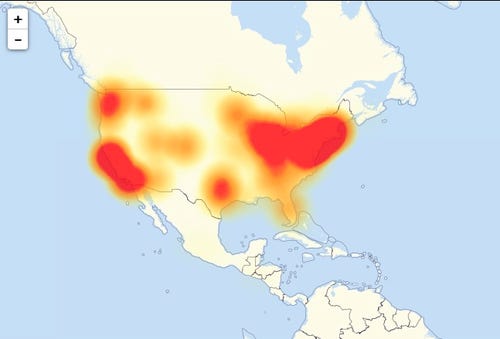SAN FRANCISCO — Eleven hours after a massive online attack that blocked access to many popular websites, the company under assault has finally restored its service. Dyn, a New Hampshire-based company that monitors and routes Internet traffic, was the victim of a massive attack that began at 7:10 a.m. ET Friday morning. The issue kept some users on the East Coast from accessing Twitter, Spotify, Netflix, Amazon, Tumblr, Reddit, PayPal and other sites.
At 6:17 p.m. ET Friday, Dyn updated its website to say it had resolved the large-scale distributed denial of service attack (DDoS) and service had been restored.
DDoS attacks flood servers with so many fake requests for information that they cannot respond to real ones, often crashing under the barrage. It's unclear who orchestrated the attack.
DDoS attacks flood servers with so many fake requests for information that they cannot respond to real ones, often crashing under the barrage. It's unclear who orchestrated the attack.
“It’s a very smart attack. We start to mitigate, they react. It keeps on happening every time. We’re learning, though” said Kyle York, Dyn’s chief strategy officer said on a conference call with reporters Friday afternoon.

Troubling to security experts was that the attackers relied on Mirai, an easy-to-use program that allows even unskilled hackers to take over online devices and use them to launch DDoS attacks. The software uses malware from phishing emails to first infect a computer or home network, then spreads to everything on it, taking over DVRs, cable set-top boxes, routers and even Internet-connected cameras used by stores and businesses for surveillance.
These devices are in turn used to create a robot network, or botnet, to send the millions of messages that knock the out victims' computer systems. The source code for Mirai was released on the so-called dark web, sites that operate as a sort of online underground for hackers, at the beginning of the month. The release led some security experts to suggest it would soon be widely used by hackers. That appears to have happened in this case.
Dyn is getting “tens of millions” of messages from around the globe sent by seemingly harmless but Internet-connected devices. “It could be your DVR, it could be a CCTV camera, a thermostat. I even saw an Internet-connected toaster on Kickstarter yesterday," said York. The complexity and breadth of the multiple attack points make it difficult to fight because it's hard to distinguish legitimate traffic from botnet traffic.
York said one bright spot for the company had been the tremendous outpouring of aid from its customers, competitors and law enforcement. “You guys wouldn’t believe the amount of support we’ve received,” he told reporters.
Effects felt nationwide - Dyn first posted on its website at 7:10 a.m. ET that it "began monitoring and mitigating a DDoS attack against our Dyn Managed DNS infrastructure."
These resolved towards 9:30 a.m. Then more waves began. "It's been a hectic day," said York. The attack comes at a time of heightened public sensitivity and concern that the nation's institutions and infrastructure could face large-scale hacking attacks. The most recent example has been the release of emails stolen from the servers of the Democratic National Committee, which U.S. intelligence sources say was the work of Russia. The topic has come up frequently during the fall's hard-fought presidential campaign.
White House Press Secretary Josh Earnest said the Department of Homeland Security was “monitoring the situation" but that “at this point, I don’t have any information about who may be responsible for this malicious activity.”
York said one bright spot for the company had been the tremendous outpouring of aid from its customers, competitors and law enforcement. “You guys wouldn’t believe the amount of support we’ve received,” he told reporters.
Effects felt nationwide - Dyn first posted on its website at 7:10 a.m. ET that it "began monitoring and mitigating a DDoS attack against our Dyn Managed DNS infrastructure."
These resolved towards 9:30 a.m. Then more waves began. "It's been a hectic day," said York. The attack comes at a time of heightened public sensitivity and concern that the nation's institutions and infrastructure could face large-scale hacking attacks. The most recent example has been the release of emails stolen from the servers of the Democratic National Committee, which U.S. intelligence sources say was the work of Russia. The topic has come up frequently during the fall's hard-fought presidential campaign.
White House Press Secretary Josh Earnest said the Department of Homeland Security was “monitoring the situation" but that “at this point, I don’t have any information about who may be responsible for this malicious activity.”
So far Dyn has not been able to ascertain whether the attack is aimed at any specific customer. “We have no reason to believe it is at this point,” said Dave Allen, the company’s general counsel. The attack is “consistent with record-setting sized cyber attacks seen in the last few weeks,” said Carl Herberger, vice president of security at security company Radware.
Disruption - A post on Hacker News first identified the attack and named the sites that were affected. Several sites, including Spotify and GitHub, took to Twitter Friday morning to post status updates once the social network was back online.
